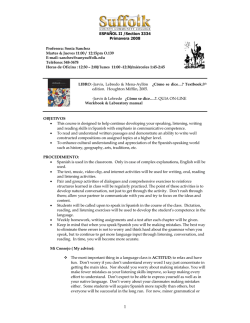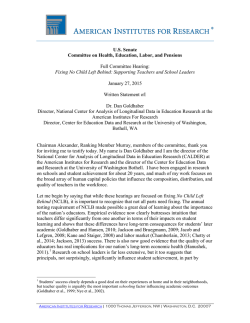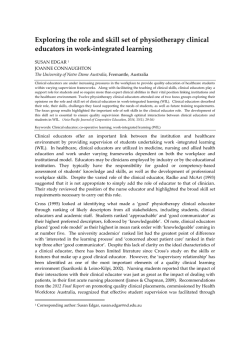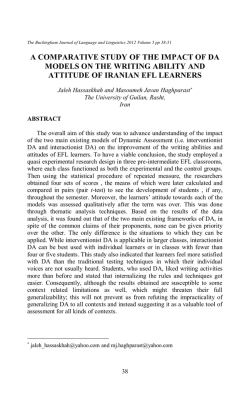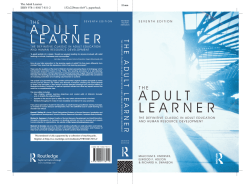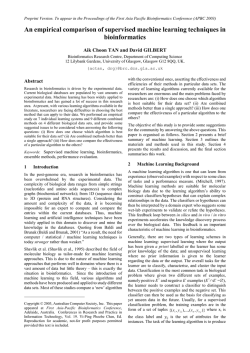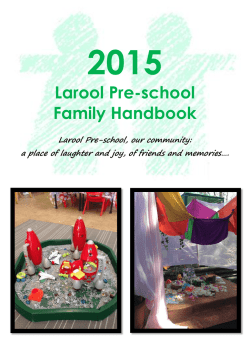
D. Tiene Assignment #6 Web 2.0 Application Overview
Sharon Doughten-Instructional Applications of the Internet Instructor: D. Tiene Assignment #6 Web 2.0 Application Overview: Online Testing Applications Most of my overview of online testing applications will focus on several new applications. These new applications have been developed and promoted as tools to enhance learning and motivation levels of the learner. My brief comments on computerbased testing (CBT) options, as an alternative to the paper-and-pencil test, will be limited to this introductory paragraph. The benefit of CBT for the learner has been well documented. A few of these benefits include; immediate feedback, real-time scoring and improved security. For instructors, the clearest advantage is that less time is spent on grading and test administration. One major concern about computer-based testing (CBT) has focused on the question of whether computer anxiety has an effect on testing performance. There is a large body of literature that has examined the question and results are still not consistent. Many educators are now beginning to explore or have put in place as a classroom supplement a learning management system. Some examples of these include Blackboard, Moodle, NineHub, and Haiku. Each of these includes options for online assessment applications. A major issue with online testing is that there is an increased likelihood that someone other than the student is completing the test. There are several ways to address this issue which include test design, course design and some new types of equipment to increase security measures. The best practice recommendation for online assessments to ensure integrity of a course is onelocation, one-time, face-to-face testing in a proctored setting (MacDonald, P. L. (2002). Cheating in distance learning remains a critical issue for educators. So let’s take a detour from this topic of concern into the world of promising new applications for engaging the learner through another type of testing application. A new line of learning applications that contain elements of social networking to promote learning has been showing up for our review as educators. My overview will include a brief glance at the following applications; MyStudiyo, Quia, Quizlet and Freerice. I do believe that these types of learner applications have been in development for a long time. If you are not looking, it is easy to miss these applications. Many educators are focused only on lessons that take place within their four walls. A good practice will always be to step outside of our usual practices to connect with new learning options that match this generation of learners. My comment on this is based upon a personal and relevant experience as a parent. For those who teach in K-12, parents can be the greatest critics of classroom opportunities for their children. I was thrilled with an online math application that my son experienced 12 years ago as a 3rd grader. The memory of its affects on his excitement about learning is still vivid in my mind. Students were given an option to be assigned a password and they could participate in an online math competition with a math game called “24”. The game enabled the learner to connect with other learners from across the globe. They competed by creating different combinations of math equations that would make the number 24 using numbers on a game card. This proved to be a great motivator for many students who had strong math skills and allowed them a positive outlet for their high energy levels. I applauded the teacher who had insight to include this as an option to this group of learners. My remaining discussion will focus on similar types of applications that can be found on the web today. MyStudiyo (www.mystudiyo.com) is one example of an application that provides educators with a format to create games, quizzes, and other learning materials. My review of this application was brought to an abrupt end when I entered the address into my web browser and the result was a new format called “Quiz Revolution”. Quiz Revolution is not a free site for creating learning tools. Therefore, I ended my review of this application. This is one of the downfalls of internet sites. You need to be diligent in your review of the site as it could be here today and gone tomorrow. Quia (www.quia.com) is another example of an application for learning. It offers online workbooks/textbook options, templates for educational tools and games and a separate learning option for math. The tools can be used free for a 30 day time period. Beyond the 30 days, a one-year subscription costs $49 for an individual. Discount pricing is offered for a group of 10 instructors or more. A third option for corporate subscriptions is intended for businesses for employee or customer training. The third application that I reviewed is “Quizlet” (http://quizlet.com). A description offered through Internet@Schools by Charles Doe states that Quizlet is an easy-to-use and efficient tool for learning. This is an application that I have wanted to explore for some time. The Office of elearning and innovation (eLi) staff at Cuyahoga Community College had been sharing features from the application with me during recent meetings. It was promoted as a free application. The description offered by Charles Doe indicated that a $10.00 fee was needed upon registration. My attempt to use the site concluded that it no longer requires this fee to get started. However, if you are interested in some of the features you will need to upgrade. This can be done easily with a $15 yearly fee. The site is extremely easy to use with clear instructions. As a user, one can make a set of flashcards or choose from millions of flashcard sets. There is an option to study with a group to share or discuss flashcards. Competitive study games are another popular option. Scatter is a matching game that allows the user to drag and drop questions and answers while racing against the clock. The study games are offered in multiple languages. The designer of this application was actually a 15 year old student needing a tool for learning French vocabulary words. Marni Jones (2012), a Learning Specialist at Shippensburg University promotes the value of Quizlet as a learning tool for students who are “study-skills deficient”. The term “study-skills deficient” was new to me but the student model fitting this term was far too familiar. Ms. Jones shares an example using Quizlet in the OnCourse Newsletter http://www.oncourseworkshop.com/Learning041.htm Her example includes a “Study Habits Feedback form” to gather information about current study practices. The students are then included in a discussion of effective study practices. An instruction session with hands-on use of Quizlet allows the learner to recognize how easy the active learning tool enables them to gain mastery of new vocabulary. Students were then able to create new sets of vocabulary independently. The responses from the students’ experiences were very positive and other teachers reported ongoing use of the Quizlet application by some students. As part of the discussion of why the application is effective with learning the students learn the difference between passive studying and active studying. The outcomes of the lesson using Quizlet are as follows: • “Promote students’ desire to learn a fun and effective new study strategy. • “Illuminate the advantages of active learning versus passive studying • “Teach and entice students to independently use the online study tool: www.Quizlet.com”. Jones states that the students expressed appreciation and shared stories of continued engagement with the learning tool. She does acknowledge that like any new game, interest waned. Continued promotion by teachers would help to keep students engaged with the application. Assigning it as required work or for bonus points would encourage use of the application for review and demonstrate the importance of making active study routine. Quizlet offers six different study modes and six different categories including: Arts & Languages, Languages & Vocabulary, Math & Science, History & Geography, Standardized Tests, and Professional & Careers. My quick review offered some reliability with the content. However, before using any of the already created tools, a review would certainly be warranted to ensure that your students are being exposed to content that is consistent with your classroom. The last learning application that I reviewed is called “Freerice”. Freerice is a nonprofit owned and supported learning application through the United Nations World Food Program. The two goals of the application are to provide free education to everyone and to help end world hunger by providing rice to hungry people. The learning topics include; Humanities, English, Math, Chemistry, Language learning, Geography, Sciences and Test preparation. It offers two strategies for learning. The primary opportunity is an active learning application option for students. Secondly, the teacher can connect learner actions with larger social needs and structures. This type of simulation helps to promote civic awareness. This concept is explored in the abstract by Bachen et. al (2012). The paragraph leads off with the following statement “Scholars, educators, and media designers are increasingly interested in whether and how digital games might contribute to civic learning.” Coanca offers that Freerice.com was developed with the following two principles of learning in mind; “language learning is an active process and learning is an emotional experience”. The article concludes that the application offers motivational learning and satisfaction for the learner from their donation of rice to people. This article refers to the value of the database having questions at different levels of difficulty and automatically adjusting to a higher or lower level as needed in response to the student answers. This particular article only references the value of freerice.com for teaching language but the listing of topics has been expanded. As with any online resource, consumers need to be aware of the potential of automatic charges that may occur in the future if a credit card was used for initial purchase. Additionally, the integrity/validity of the material needs to be researched and monitored. These last two free learning web 2.0 applications offer much promise of what future developments might offer for educational environments. There is often much discussion about the negative implications of online learning applications. These discussions may close out many windows of great opportunity. Schank speaks of the teachable moment as a brief window where the learner is most receptive to new information that is focused, personalized, and in context (Anderson, 2011). As educators we must always keep this opportunity for learning in mind with our lesson development. Anderson, Terry. The Theory and Practice of Online Learning, 2nd ed. Edmonton: AU, 2011. Bachen, C. M., Hernández-Ramos, P. F., & Raphael, C. (2012). Simulating REAL LIVES: Promoting Global Empathy and Interest in Learning Through Simulation Games. Simulation & Gaming, 43(4), 437-460. doi: 10.1177/1046878111432108 Coanca, M. (2012). Freerice.com-Free education based on appealing level-based English tests, The 8th International Scientific Conference eLearning and software for Education, Bucharest, April 26-27. Jones, M. (2012). http://www. Oncourseworkshop.com/Learning 041. htm MacDonald, P. L. (2002). Cheating on Tests: How to Do It, Detect It, and Prevent It. International Journal Of Testing, 2(3/4), 369. Product reviews. (2011). Internet@Schools, 18(4), 29-32.
© Copyright 2026
